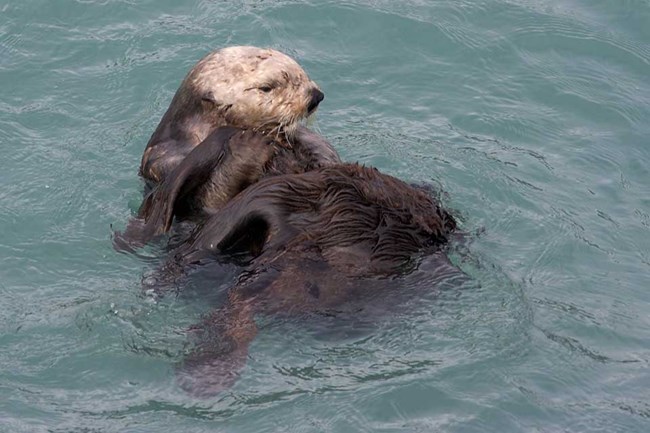Last updated: October 26, 2021
Article
Future Directions in Sea Otter Research and Management

NPS/Jim Pfeiffenberger
Sea otters are a keystone species in nearshore marine environments. A keystone species dramatically affects the structure and complexity of their environment. Sea otters are important mammalian members of the nearshore community throughout the north Pacific and are the only marine mammal that relies exclusively on shallow or intertidal macroinvertebrates as prey. By consuming grazers—the animals that feed on kelp—sea otters dramatically change the structure and complexity of their ecological community, resulting in communities characterized by diverse and abundant algae and relatively few large grazing invertebrates, such as sea urchins. Other well-documented sea otter-mediated predation effects include reduced biomass and size distributions of many large and conspicuous invertebrates, such as clams, mussels, urchins, and crabs. Sea otters tend to have small home ranges in comparison to other marine mammals; eat large amounts of food; have an incidence of disease that is correlated with contaminants; and have broad appeal to the public.
In 2005, sea otter populations in the southwest Alaska population segment (which includes coastal habitat of Katmai National Park and Preserve) were listed as threatened under the Endangered Species Act. Further, the U.S. Fish and Wildlife Service designated almost 6,000 miles of coastline in southwest Alaska as critical habitat for the northern sea otter. Critical habitat is habitat that is deemed essential for the conservation of a threatened (or endangered) species. Monitoring sea otter populations, as well as other components related to sea otter status, in nearshore ecosystems will result in important information to better understand population trajectories.
Future Directions in Sea Otter Research and Management
The conservation and management of sea otters has benefited from a dedicated research effort over the past 60 years enabling this species to recover from a few thousand in the early 20th century to about 150,000 today. Continued research to allow full, pre-exploitation recovery and restoration of nearshore ecosystems should focus on at least seven key challenges: (1) Defining sea otter populations at smaller spatial scales that reflect this species’ life history and dispersal patterns; (2) Understanding factors that regulate sea otter population density with a focus on index sites that are representative of the variety of littoral habitats occupied by sea otters around the North Pacific Rim; (3) Quantifying the effects of sea otters on the littoral community with a focus on how food availability limits population and ecosystem recovery and on predicting the effect of sea otter reoccupation on commercially valuable invertebrates; (4) Making sea otter monitoring programs comparable across geo-political boundaries through international collaboration to optimize survey efforts both spatially and temporally and to determine the cause of changes in sea otter demographics; (5) Evaluating the conservation benefits of sea otter reintroductions into historical habitat; (6) Assessing the socioeconomic costs and benefits of sea otter range expansion to anticipate and mitigate conflicts; (7) Recognizing in conservation and management plans that sea otters can be significantly affected by higher level predators in some circumstances. Many of these challenges will require new tools including the next generation geolocation tag technology that will allow assessments of long-range movements, dispersal and gene flow in various populations.
Davis, R. W., J. L. Bodkin, H. A. Coletti, D. H. Monson, S. E. Larson, L. P. Carswell, and L. M. Nichol. 2019. Future directions in sea otter research and management. Frontiers in Marine Science DOI:10.3389
